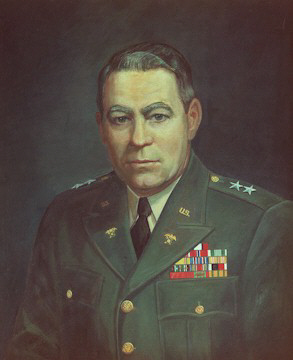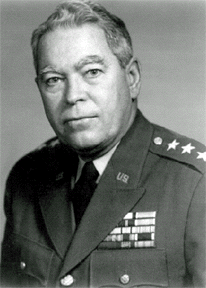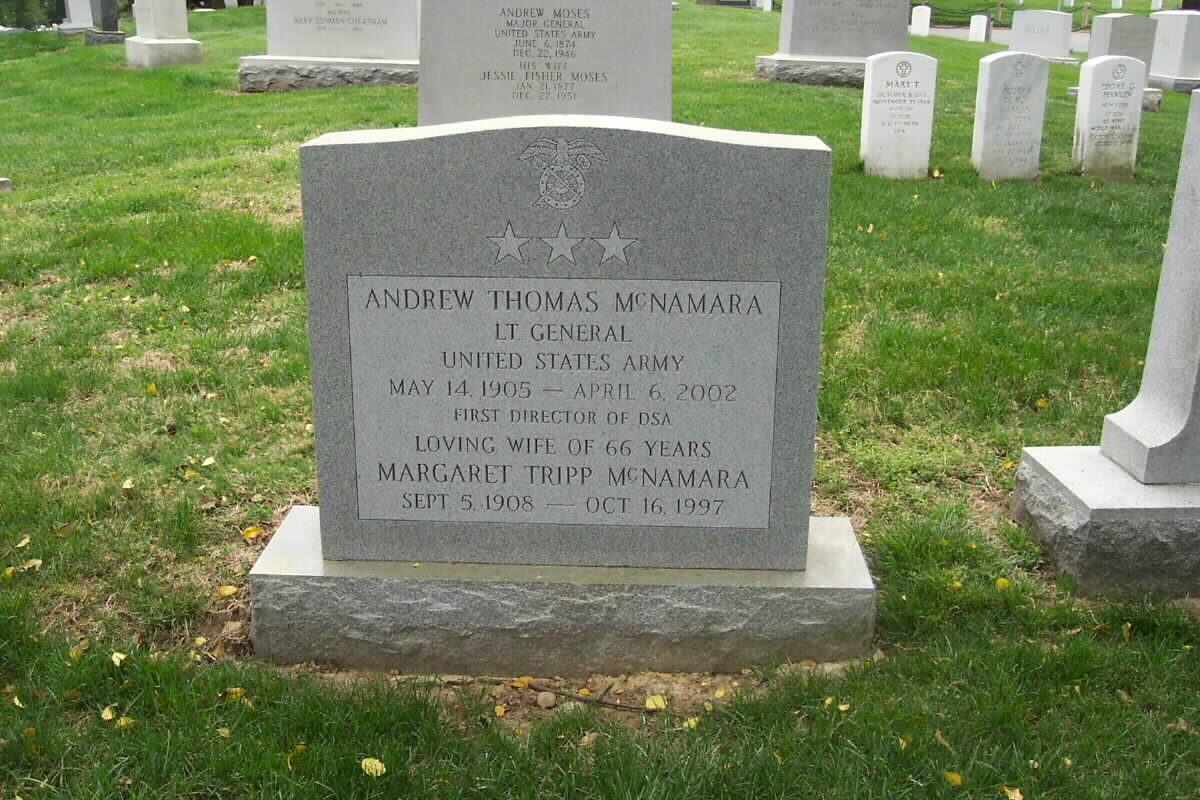From a contemporary press report
Andrew Thomas McNamara, 96, a retired Army Lieutenant General who rose through the Quartermaster Corps to serve as the first director of what is now the Defense Logistics Agency, died of pneumonia April 6 at the Fairfax retirement home at Fort Belvoir, Virginia.
General McNamara, former quartermaster general and a decorated World War II logistician, was appointed by then-Defense Secretary Robert McNamara (no relation) to head the Defense Supply Agency in 1961 as a way to centralize the supply management of the different branches of the military.
He oversaw a relatively small staff of about 100 planners who ran supply depots and service operations in 10 cities. The consolidation led to a reduced workforce and savings of more than $30 million.
He retired in 1964, a year after he was awarded the Oak Leaf Cluster to the Distinguished Service Medal for “significant savings” made through the rapid standardization of items managed by the Defense Supply Agency.
General McNamara was born in East Providence, Rhode Island, where he was an accomplished high school athlete. He graduated from the U.S. Military Academy at West Point in 1928 and was commissioned a Second Lieutenant in the Infantry. After eight years in the infantry, he transferred to the Quartermaster Corps in 1937 and served in various quartermaster positions in the continental United States.
At the beginning of World War II, he went to England to help organize the main supply line in North Africa. He received the Legion of Merit for providing food, gasoline and other supplies to fast-moving U.S. forces in Tunisia.
He received the Bronze Star for his part in planning quartermaster support for the invasion of Normandy.
As Allied forces pushed across Western Europe, Gen. McNamara's units were responsible for supplying 12 divisions, which swelled to 22 by war's end.
He also was credited with personally directing the evacuation of a huge supply dump before German soldiers could reach it during the Battle of the Bulge.
After the war, General McNamara served briefly as quartermaster of the First Army and later as chief of the subsistence branch of the office of the Quartermaster General in Washington.
His other assignments included commandant of the Quartermaster School at Fort Lee, Virginia, executive officer to the undersecretary of the Army and chief of the storage and distribution division of the office of the deputy chief of logistics.
President Dwight D. Eisenhower nominated him to be Quartermaster General in 1957. In this capacity, he was responsible for myriad supplies and services, including uniforms, food, petroleum, field shelter, and maintenance of more than 80 national cemeteries.
In retirement, he served as president and secretary of the Defense Supply Association and managing editor of its bimonthly publication.
His wife of 66 years, Margaret McNamara, died in 1997. A son, Andrew T. McNamara, died in 1985.
Survivors include a son, retired Army Lieutenant Colonel William T. McNamara of Alameda, California, and four grandchildren.
Courtesy of the United States Army Quartermaster Museum
Lieutenant General Andrew T. McNamara
3th Quartermaster General
June 1957 – June 1961
Andrew Thomas McNamara was born in East Providence, Rhode Island, on 14 May 1905. He graduated from the U.S. Military Academy and was commissioned a Second Lieutenant in the Infantry on 9 June 1928. His first assignment was with the 28th Infantry at Madison Barracks, New York.
In April 1931, General McNamara was transferred to the 35th Infantry at Schofield Barracks, Hawaii, where he served until June 1933. He was then assigned as a company commander with the Civilian Conservation Corps at Alexandria, Louisiana. He entered the Infantry School in September 1933, and graduated the following June. Afterwards he attended the Quartermaster Subsistence School in Chicago, and graduated from there in June 1935.
General McNamara then became Subsistence and Sales Commissary officer at Fort McPherson, Georgia, and in July 1936, was named sales officer at Fort Devens, Massachusetts. In August 1937 he officially transferred into the Quartermaster Corps.
In July 1940, then Major McNamara became Assistant Quartermaster at Fort Sam Houston, Texas. A year later he was appointed Assistant Director of Supply and Executive Officer at the newly constructed Quartermaster Replacement Training
Center at Camp Lee, Virginia.
In July 1942, General McNamara became Assistant Quartermaster of the II Corps in England. The following November he was appointed Chief Quartermaster of the II Corps, and moved with them to establish the principal supply line in North Africa during Operation TORCH. Major General Robert M. Littlejohn, then Chief Quartermaster of the European Theater of Operations (ETO), often referred to the outstanding job done by “that brilliant Colonel McNamara” in North Africa. In September 1943, following the Sicilian campaign, McNamara was brought to England and assigned as Chief Quartermaster of the First Army — in preparation for the D-Day landing at Normandy.
General McNamara performed extremely valuable service on the European continent throughout the remainder of World War II. From D-Day on units under his command supplied a minimum of 12 divisions on the continent, and provided services which would have been deemed impossible a generation earlier. The German counter-attack in December 1944 (better known as the “Battle of the Bulge”) became something of a personal matter to General McNamara. He sensed that the enemy's immediate objective was to seize as much as possible of the Allies' supplies — especially gasoline. McNamara's First Army quartermasters responded with a spirit and enthusiasm which reflected credit upon the QMC as a whole. On one notable occasion, for instance, they successfully evacuated more than 3,000,000 gallons of gasoline in three days. By January 1945, the First Army had completely restored its lines of communication, and were again moving supplies eastward in an orderly fashion.
For his outstanding service in North Africa and Europe, General McNamara was awarded the Distinguished Service Medal, Legion of Merit, Bronze Star Medal, Army Commendation Ribbon, and several foreign decorations, including French Croix de Guerre with palm, French Legion D'Honneur, and the Luxembourg Order De La Couronne DeChenne. Following V-E Day, General McNamara returned to the United States in May 1945. He served for a short time in the Southwest Pacific Theater of Operations, then in August was assigned as Quartermaster of the First Army at Fort Bragg, North Carolina.
In February 1946, General McNamara was appointed Chief of the Subsistence Branch, Office of the Quartermaster General, in Washington D.C. He entered the National War College in September 1947 and graduated the following spring. Afterwards he was assigned to the Plans and Operations Division of the Army General Staff (1948-49) and as Assistant to Executive Secretary of the Secretary of Defense (1949-50).
In 1950, shortly after the beginning of the Korean War, General McNamara became Commandant of the U.S. Army Quartermaster School at Fort Lee. While serving in this position he instituted a major reorganization of the Command, stepped up training to meet the sudden needs of the Korean conflict, and oversaw the consolidation of airborne logistics operations and training at Fort Lee.
In September 1951, General McNamara returned to Washington as Executive to the Under Secretary of the Army. He remained there until March 1953, when he was assigned to the Army General Staff. He was appointed Chief of the Storage and Distribution Division, Office of the Deputy Chief of Staff for Logistics (DCSLOG) in September 1954, then Director of Supply Operations, DCSLOG, the following April. General McNamara returned to Europe in July 1956 as Assistant Chief of
Staff, G-4, USAREUR.
On 18 April 1957, General McNamara was nominated by President Eisenhower to become The Quartermaster General. His nomination was confirmed by the Senate on May 9th, and he took the oath of office on June 12th. Under his inspired leadership, the next four years saw a vast expansion of Quartermaster activities worldwide, especially as the Single Manager concept continued to evolve. The Quartermaster Corps also increased its responsibility for the establishment of general depots and direct support. And enormous strides were made in Quartermaster research and development.
Following his tour as Quartermaster General, McNamara served for a brief period (July-September 1961) as Deputy Commanding General, Eighth U.S. Army, in Korea. He was summoned back to the states in mid-September to become the first Director of an unprecedented military logistics organization, the Defense Supply Agency. He and his relatively small staff of around 100 planners virtually wrote the book at DSA. Lieutenant General McNamara continued as head of DSA until his retirement from the Army on 30 June 1964, after 36 years of active service. Following retirement he served for another decade as president and secretary of the American Logistics Association (formerly the Defense Supply Association) and managing editor of that organization' s bimonthly publication, The Review.
General McNamara’s well-deserved reputation, his many years of leadership experience, and his overall contribution to the development of the Quartermaster Corps, are known and admired throughout the Army.
General McNamara was inducted into the Quartermaster Hall of Fame in 1988 and was inducted as a Distinguished Member of the Quartermaster Regiment in 1991 (Charter Year). In 1998 he was awarded the Ancient Order of Saint Martin recognizing his conspicuous, long-term service to the Quartermaster Corps.
On October 15, 1998, the Quartermaster Museum dedicated its new permanent supply gallery in honor of General McNamara. The “McNamara Supply Gallery” opened during Quartermaster Regimental Week on 18 June 1999.
From a contemporary press report
Margaret Tripp McNamara, 89, a native of Watertown and wife of retired Army Lieutenant General Andrew T. McNamara, died October 16, 1997, at Fairfax Retirement Home, Fort Belvoir, Virginia.
Accompanying her husband to his many posts, Mrs. McNamara volunteered as a nurse's assistant at the post hospital at Schofield Barracks, Hawaii, in Germany and Korea and at many other stations in United States. She was often instrumental in ensuring the welfare and dignity of refugee women and children while at her various posts.
Mrs. McNamara was devoted to her church and became a member of the Ladies of the Holy Sepulcher of the Roman Catholic Church.
In later years, she also enjoyed painting.
Born September 5, 1908, in Watertown, a daughter of George W. and Helen Stimpson Tripp, she attended Holy Family High School. Her father was a former secretary and treasurer of Treadwell Supply Co., Inc. and was a well-known figure in paper mill supply circles.
She married Lieutenant Andrew T. McNamara on Feb. 12, 1931, at Holy Family Church with the Rev. Joseph P. Heslin, assistant pastor, officiating. The couple maintained a home in Watertown for a time following their marriage. They retired to the Washington, D. C., area in 1965.
Lieuteant McNamara, a career soldier and native of Providence, Rhode Island, reached the rank of lieutenant general. He graduated from West Point in 1928, and is a veteran of eight major engagements.
He was first stationed at Madison Barracks, Sackets Harbor, from 1928 to 1931, with the 28th Infantry. He was later assigned to various posts throughout the world.
Spending most of his career in the quartermaster corps, he retired from military service after more than 36 years of active service. He then became head of the multibillion-dollar Defense Supply Agency, and later operated a store specializing in imported foods.
Surviving besides her husband are a son, retired Lt. Col. William T. McNamara, Sunnydale, Calif.; four grandchildren and two great-grandchildren.
A son, Colonel Andrew T. McNamara, died in 1985. A brother, attorney George S. Tripp, died in 1949. Another brother, Dr. Henry S. Tripp, also died before her.
The funeral will be at 2:45 p.m. Thursday at Old Post Chapel, Fort Myer, Virginia, with the Army chaplain officiating. The rosary will be recited at 3 p.m. Burial will be in Arlington National Cemetery.
Michael Robert Patterson was born in Arlington and is the son of a former officer of the US Army. So it was no wonder that sooner or later his interests drew him to American history and especially to American military history. Many of his articles can be found on renowned portals like the New York Times, Washingtonpost or Wikipedia.
Reviewed by: Michael Howard



